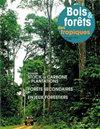塞内加尔卡亚(Khaya senegalensis)生长单位形态的变异答:法律原则。, 1830 (Meliaceae)和Pterocarpus erinaceus Poir。, 1804年(豆科),根据生境和气候
IF 0.6
4区 农林科学
Q3 FORESTRY
引用次数: 1
摘要
回顾性分析提供了获得长期生长序列的途径,以了解和解释树冠可持续管理所需的结构功能。本研究的目的是评估塞内加尔海杉(Khaya senegalensis)和羊角蕨(Pterocarpus erinaceus)冠状芽的发育和对变化环境的适应,为建立永久样地做准备。对Côte科特迪瓦7个地点420只幼虫、成虫和老年虫的生长单位(GUs)形态进行了旱季和雨季全光照或遮荫条件下的分析。结果表明,生长单位形态是生长条件选择的一个指标。不同生境对生长单位形态无显著影响(P > 0.05)。不同地区(气候)生长单位的形态因环境特征不同而存在差异(P < 0.05)。坡度的南部(该国中部的Toumodi和bouak本文章由计算机程序翻译,如有差异,请以英文原文为准。
Variation on growth unit morphology in Khaya senegalensis (Desr.) A. Juss., 1830 (Meliaceae) and Pterocarpus erinaceus Poir., 1804 (Fabaceae) according to habitat and climate
Retrospective analysis provides access to long-term growth series to understand and interpret the structural functioning of tree crowns required for their sustainable management. The aim of this study was to assess the development and adaptation of crown shoots in Khaya senegalensis and Pterocarpus erinaceus to a changing environment in preparation for establishing permanent plots. The growth units (GUs) morphology of the axes of 420 young, adult, and old individuals was analyzed in full sunlight or shade during the rainy and dry season in seven locations in Côte d'Ivoire. The results showed that growth unit morphology is an indicator of the choice of growth conditions. Heterogeneous habitat had no significant effect on growth unit morphology (P > 0.05) in either species. The morphology of the growth units varied from one location (climate) to another due to distinct environmental characteristics (P < 0.05). The southern part of the gradient (Toumodi and Bouaké in the central region of the country) offers favourable and hence priority areas for reforestation programmes based on the two species. The age of the individuals influenced the number of phytomers per growth unit (P < 0.05). Young individuals (cuttings) are good ideotypes for the selection of suitable resistant genotypes. Whatever the species, the rainy season increased the success rate of plot establishment. The growth units of the two species are practically the same size (P > 0.05). Our results could be a decision guide for the selection of suitable environments for the implementation of reforestation or agroforestry programs based on Khaya senegalensis and Pterocarpus erinaceus, in order to conserve and sustainably manage these species in the current climate change context.
Keywords: Khaya senegalensis, Pterocarpus erinaceus, Environment, Morphology, Growth Units (GUs)
求助全文
通过发布文献求助,成功后即可免费获取论文全文。
去求助
来源期刊

Bois et Forets Des Tropiques
FORESTRY-
CiteScore
1.50
自引率
16.70%
发文量
31
审稿时长
>12 weeks
期刊介绍:
In 1947, the former Tropical Forest Technical Centre (CTFT), now part of CIRAD, created the journal Bois et Forêts des Tropiques. Since then, it has disseminated knowledge and research results on forests in intertropical and Mediterranean regions to more than sixty countries. The articles, peer evaluated and reviewed, are short, synthetic and accessible to researchers, engineers, technicians, students and decision-makers. They present original, innovative research results, inventions or discoveries. The journal publishes in an international dimension. The topics covered are of general interest and are aimed at an informed international audience.
 求助内容:
求助内容: 应助结果提醒方式:
应助结果提醒方式:


